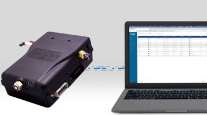The Evolution of Tractor-Trailer Connectivity

[Find the latest in equipment & maintenance: Explore this quarter's issue of Calibrate]
ATA's Technology & Maintenance Council is nearing the culmination of a multiyear effort to define the evolutionary direction of tractor-trailer connectivity, even as more advanced technologies are becoming — or soon will be — available in the marketplace.
The council’s recent Annual Meeting and Transportation Technology Exhibition in Orlando, Fla., helped spur significant progress toward solidifying that definition.
The Next Generation Tractor-Trailer Interface Task Force of TMC’s S.1 Electrical Study Group held an important session Feb.28, marking the start of a process to evaluate potential concepts for a new connector to replace the long-standing SAE J560 standard connection that TMC and American Trucking Associations members helped pioneer several decades ago.
It is generally accepted now that the venerable SAE J560 interface must be modernized to meet new customer and supplier recommendations and allow for the advancement of technologies now available to the trailer market. The application of technologies vetted in the automotive and tractor markets that promise improved safety, efficiency and durability cannot be applied due to the low bandwidth and relatively low conductor count of the J560.

Legler
Calls and attempts to modernize the J560 interface are not new. SAE J2691, first published in 2013, was meant to replace J560 and included the additional communications and extra conductors to allow the trailer to advance at a similar rate to that of the tractors in the industry. However, the J2691 interface has not seen significant market penetration. This is generally understood to be because it is not backward compatible with the J560 interface, and truck/trailer retrofits would require significant investment and industrywide coordination.
While this robust, tried-and-true 12-volt connector is utilized ubiquitously throughout the North American market, the power and data demands of each generation of technology advancement have pushed the limits of what can be done with this connection.
More Q2 Calibrate
►Standard Sought for Brake Lining Classification
►Freeze: Participating in the Right to Repair Debate
►Fleets Weigh Lift Equipment
►5 Questions With Rig Runner's Jay Rincker
►Baxter: New Oil Standard Will Help Fleets
►TMC Corner: The Evolution of Tractor-Trailer Connectivity
Explore the Issue!
Multivoltage requirements, solar installations, electric drive and regenerative braking axles, advanced driver assistance systems and automated driving systems — and the host of sensors, emitters and cameras that support them — mean the need for a new connector standard is increasingly necessary and urgent.
To help develop what should be a multisubnet, multivoltage, integrated combination vehicle, TMC established two task forces:
• The Next Generation Trailer Electrical Architecture Task Force under the Council’s S.7 Trailers, Bodies & Material Handling Study Group completed its work with the publication of position paper TMC PP 2023-1: Design Recommendations for Next Generation Trailer Electrical Architecture, on Feb.17. This document contains 13 “guiding principles” as to what must be supported in terms of power, command control and data needs in trailer safety and telematics technology.
The TMC Position Paper also lays out additional considerations for cybersecurity to include protecting the confidentiality of trailer contents; availability of tractor/trailer and information technology systems; integrity of trailers, tractors and other information systems; and the anonymity of trailers.
• The S.1 Next Generation Tractor-Trailer Interface Task Force completed drafting of a second proposed position paper that, in addition to the “guiding principles,” will lay out the design criteria that new physical connections must fulfill. This “S.1 interface” is an imaginary interface that exists between a trailer and the truck that is pulling it; it is not necessarily meant to represent any specific product or idea that already exists in the market. It is possible that an interface capable of meeting all recommendations described in the needs assessment paper already exists, but the intention of the construction of the recommendations was to describe an “ideal” interface and to not be constrained by existing art. However, significant consideration was given to available and yet-to-be available technology, and the interface is expected to be backward compatible, yet expandable.
The Next Generation Tractor-Trailer Interface Task Force’s meeting in February included a “see and touch” display of eight proposals of conceptual designs and prototypes submitted in response to an open invitation from S.1. The number and quality of the submissions was a welcome surprise, so much so that TMC has determined that a structured process is needed to take the next steps forward.

Kayne Grau, CEO of Uptake, discusses ways that fleets can use data to prevent expensive truck repairs. Hear the program above and at RoadSigns.TTNews.com.
The process that will be followed through the rest of this year will consist of two phases:
• Phase I, already underway, will involve a series of task force webinars, during which each proposed solution will be presented in detail with an opportunity for discussion with the presenters’ technical experts. After these presentations, task force members will be asked to evaluate how well each prototype would provide the trailer support needs of the “guiding principles” as well as the desired technical performance criteria. The task force’s findings will then be presented at TMC’s 2023 Fall Meeting in Cleveland in September.
• Phase II will then involve polling the fleets to determine which solution or solutions will be their reference. TMC would then likely begin the process of developing a Recommended Engineering Practice to finalize the criteria for a new standard design.
TMC recognizes that the challenges facing future combination-vehicle connectivity are not easy. With millions of trailers in use with as much as 20 years of expected service life in many duty cycles, protecting the investments in these legacy assets is paramount, and the reality of fleet operations will require a “mixing and matching” of multiple generations of units and technologies on an ongoing basis. While adoption of a new tractor-trailer connection will be organic and market driven, TMC is engaged in this process to provide for transparency and objectivity so that the transition can be rational, driven by practicality and ultimately in best meeting the needs of fleets.
Want more news? Listen to today's daily briefing below or go here for more info:





